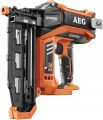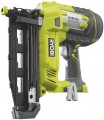Performance
The maximum output of a nailer/stapler is the maximum number of strokes it can produce in a minute. Note that in this case, the theoretical maximum is usually indicated — the highest speed of operation achievable under perfect conditions, in fact — the rate of operation of automation, which in many models exceeds 120 beats / min. In fact, this speed is difficult to achieve, because. the performance of the stapler is noticeably limited by the skills of the operator and the features of the functionality: for example, a tool with contact actuation (see below) must be pressed every time, which reduces the speed of work. However,
high performance clearly indicates good reliability and suitability for large volumes of work.
Magazine capacity
The number of fasteners that fit in the stapler magazine.
Note that manufacturers tend to indicate the maximum number of parts in the characteristics — that is, the capacity for the thinnest fasteners allowed by the design of the tool. Accordingly, fewer larger parts will fit in the store; this must be taken into account when choosing. Nevertheless, this parameter makes it possible to evaluate the instrument and compare models similar in class to each other.
Large capacity, on the one hand, allows you to work longer without interruptions to recharge the stapler. On the other hand, volume magazines are usually very bulky and can weigh a lot on their own, not to mention the weight of the fasteners loaded in them. Also, if parts are charged one at a time, recharging can become quite a long and tedious affair. Therefore, it makes sense to specifically look for a tool
for 100 parts or more(especially when it comes to thick fasteners) only if the ability to work for a long time without reloading is more important than the disadvantages described above.
Min. nail diameter
The smallest thickness of nails (see "Type of fastener") that the stapler can work with.
A nail that is too thin is just as undesirable for a tool as one that is too thick: already in the store, such parts can hang out, and there is no question of correct “shooting” at all. Therefore, this limitation should definitely be taken into account when choosing, especially if you plan to work with nails of small thickness. The most "thin" modern staplers have a minimum limit of about 1 mm, and in professional models it can exceed 2.5 mm and even 3 mm.
Functions
—
Adjustment of impact force / depth. The ability to adjust the force of impact or the depth of clogging fasteners. These functions are implemented somewhat differently: the impact force is changed by adjusting the power supplied to the striker upon impact, and the driving depth can be set due to a mechanical limiter — for example, by retracting the striker a certain distance back, so that it simply does not was able to move beyond a certain distance. However, the purpose and use of these functions is similar: first of all, they allow you to change the depth to which the fastener is driven into the material. In addition, adjusting the force of impact (namely force) can be useful when working with delicate materials, where too powerful impacts are undesirable. Specific details of the implementation of this function should be clarified in each case separately.
—
Double hit. Possibility of operation of the stapler in the double impact mode. Here, this term means the ability to drive two fasteners at once in one blow — for example, for connections that require increased reliability. Note that double impact most often only works on staples, even if the tool is able to work with other types of fasteners (see above). Firstly, it is for brackets that this possibility is most relevant; secondly, it is much more difficult to implement it for nails or pins.
—
Bending the staple.... The ability of the stapler to work not only for driving staples, but also for bending their legs after installation. The need for bending arises in cases where the tool is used to fasten relatively thin layers of material, and the staples pierce the parts to be fastened through: bent legs provide a secure hold, and are also safer — the risk of scratching or pricking the protruding edge of the staple is minimal. Note that such work requires an anvil of hard material placed under the fastened materials; in some tools with a bending function, the anvil is part of the design, but most often it is not.
— Blade of knife. The presence of a knife blade in the design of the stapler. This feature allows you to use the tool not only for driving fasteners, but also for cutting material — for example, preparing upholstery for furniture. The blades are usually made removable (so that a dull one can be quickly replaced with a fresh one or sharpened with convenience) and have a beveled shape (this allows you to cut with the very tip of the knife, providing high accuracy and accuracy). However, this function is quite specific, therefore it is rare, and mainly among percussion models (see "Type") — only they turn out to be quite light, compact and convenient for use as knives.
— Backlight. The presence in the stapler of its own built-in flashlight, usually directed in such a way as to highlight the place of impact. This feature is extremely useful when working in low light conditions. Note that such conditions can easily arise even under normal ambient lighting: for example, the tool itself often obscures the impact site, worsening visibility and complicating accurate aiming.
— Brushless motor. Such motors do not have the classic carbon brushes found in conventional power tools, whose friction during engine operation leads to additional heating, which leads to unnecessary energy consumption and general engine wear. Refusal to use them allows you to extend the battery life of the tool, on the one hand, as well as the life of the engine, on the other.Battery platform
The name of the battery platform supported by the device. A single battery platform is used to combine various power tools of the same brand (screwdriver, grinder, circular saw, etc.) into one line. Devices on the same platform use interchangeable batteries and chargers. Thanks to this, for example, there is no need to select a battery for each individual model of a power tool, because one purchased as a spare battery can be used in various power tools, depending on the situation or as needed. Batteries of the same platform basically differ from each other except perhaps in capacity.
Compatible batteries
Battery models compatible with the tool.
When choosing a tool, this information is relevant mainly for models without a battery included. For tools that come with batteries, the battery model is more of a reference—it's mostly "for the future" if a spare or replacement battery is needed. However, this data can also be useful in the selection process — for example, to assess compatibility with an existing battery on the farm, or to find detailed data on compatible batteries and determine how they meet your requirements (in particular, there are formulas that allow you to determine the time of continuous operation from a specific battery; these formulas can be found in special sources).
Nails included
The number of nails supplied with the stapler.
Construction staplers can be supplied with a stock of fasteners (staples, nails, pins) — so that you can immediately start working without buying more consumables. And knowing the number of such parts, you can not only determine how much the initial stock will last, but also evaluate how profitable the purchase of this model will be compared to the model without consumables in the kit. For example, a relatively expensive model that comes with 200 nails, as a result may be more profitable than a cheaper tool that does not come with any fasteners.
Case (bag)
The presence of a case or bag in the tool kit.
Such accessories are more convenient than impromptu packaging, they greatly simplify the storage and transportation of both the tool itself and accessories / consumables. At the same time, cases are the most popular in construction staplers — characteristic suitcases made of solid material. Such a suitcase perfectly protects the instrument not only from moisture and dirt, but also from shocks and shocks; it is also often used as the factory packaging in which the tool goes on sale. Bags made of soft material, in turn, are less common: they do not provide such protection against impacts, and they do not resist water / dust as effectively. On the other hand, such packaging itself is less bulky, and when the bag is not needed, it can be rolled up quite compactly.

